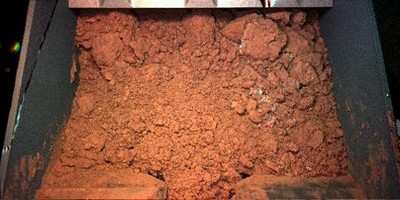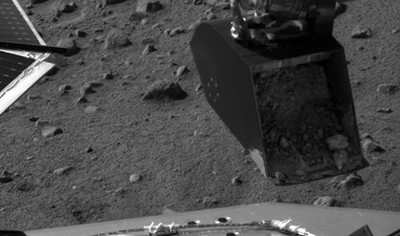Tue, Jun 10, 2008
Just A Little Sprinkle Might Do It
A revised method for delivering soil samples by the Robotic Arm
to laboratory instruments on NASA's Phoenix Mars Lander may yield
some success to failed earlier efforts now that researchers
appreciate how clumpy the soil is at the landing site.

"We're a little surprised at how much this material is clumping
together when we dig into it," said Doug Ming a Phoenix science
team member from NASA's Johnson Space Center, Houston.
As reported Sunday by ANN,
Phoenix’s instruments showed a vibrator on the screen --
designed to help shake soil into the chamber -- was working. But
the electronic sensor to detect dirt falling into the Thermal and
Evolved-Gas Analyzer (TEGA) chamber didn't report any
particles.
The TEGA is designed to bake and sniff samples to identify some
key ingredients central to the focus of the mission to determine if
the northern permafrost region may have the ability to support
life. The analyzer vibrated the screen for 20 minutes on Sunday but
detected only a few particles of the challenging soil getting
through the screen, not enough to fill the tiny oven below.

"We are going to try vibrating it one more time, and if that
doesn't work, it is likely we will use our new, revised delivery
method on another thermal analyzer cell," said William Boynton of
the University of Arizona, lead scientist for the instrument.
The initial method of delivery to get the first sample to TEGA
on Friday required the arm to turn the scoop over and release
it’s contents at once. A revised method requiring the arm to
hold the scoop at an angle above the delivery target and sprinkle
out a small amount of the sample by vibrating the scoop with a
motorized rasp at the bottom was to be attempted Monday.

Sunday, Phoenix used the arm to collect a soil sample for the
spacecraft's Optical Microscope. Monday’s plans included a
practice of the sprinkle technique, using a small amount of soil
from the sample collected Sunday.
If that goes well, the Phoenix team assembled at the University
of Arizona plans to sprinkle material from the same scoopful onto
the microscope later this week.
More News
Aero Linx: Model Aeronautical Association of Australia MAAA clubs are about fun flying, camaraderie and community. For over 75 years, the MAAA has been Australia’s largest fl>[...]
Touchdown Zone Lighting Two rows of transverse light bars located symmetrically about the runway centerline normally at 100 foot intervals. The basic system extends 3,000 feet alon>[...]
“Discovery and innovation are central to our mission at Virgin Galactic. We’re excited to build on our successful record of facilitating scientific experiments in subor>[...]
How To Get A Story On Aero-TV News/Feature Programming How do I submit a story idea or lead to Aero-TV? If you would like to submit a story idea or lead, please contact Jim Campbel>[...]
Student Pilot Reported That During Rotation, “All Of A Sudden The Back Of The Plane Kicked To The Right..." Analysis: The student pilot reported that during rotation, “>[...]
 ANN's Daily Aero-Linx (05.02.24)
ANN's Daily Aero-Linx (05.02.24) ANN's Daily Aero-Term (05.02.24): Touchdown Zone Lighting
ANN's Daily Aero-Term (05.02.24): Touchdown Zone Lighting Aero-News: Quote of the Day (05.02.24)
Aero-News: Quote of the Day (05.02.24) ANN FAQ: Contributing To Aero-TV
ANN FAQ: Contributing To Aero-TV NTSB Final Report: Cirrus Design Corp SR20
NTSB Final Report: Cirrus Design Corp SR20





